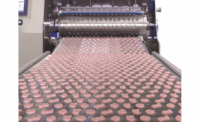Maximizing Conveyor Cleanliness
by Richard Mitchell
Machine uptime and plant cleanliness are being given even greater priority by manufacturers of conveyor systems and components.
In response to heightened concerns by retailers, consumers, and government agencies over the threat of product contamination, conveyor systems suppliers are creating technologies that are intended to kill microbes, eliminate bacteria breeding areas, and allow apparatus to be cleaned more quickly and thoroughly. At the same time, conveyor life is being extended with features that place less stress on belts and protect key components from moisture, cleaning detergents, food particles, and other potentially troublesome elements.
Material Systems Engineering Corp., for instance, a Tampa, FL-based conveyor company, is marketing frames with minimal horizontal surface areas for faster cleansing and to reduce moisture retention. Compared to most traditional conveyors, Material Systems’ apparatus requires 30 percent fewer chemicals, 25 percent less water, which results in a 20 percent reduction in labor during sanitizing, says President Dan Karpy.
The desire for technologies that facilitate quick, easy, and efficient cleaning led Michael Foods, a Minneapolis-based processor, to recently install a Material Systems conveyor in its plant, says Ted Kurpgeweit, senior engineer.
“Many companies produce conveyors that enable the transport of products from point A to point B, but being able to install a unit that can be thoroughly cleaned is one of the most important considerations for a processor,” he notes. “Sanitation is a top priority.”
To further reduce the threat of contamination, Material Systems and other conveyor manufacturers also are incorporating antimicrobials in belts, skid rails, bearing housings, and other apparatus.
Shuttleworth Inc., a Huntington, IN-based conveyor developer, integrates antimicrobials in the thermoplastic rollers that are part of its Easy Clean conveyor line. Shuttleworth also has a dearth of horizontal surfaces on its Easy Clean and its Slip-Torque conveyor systems to prevent food and other potential sources of bacteria from collecting on the apparatus, says Todd Eckert, Shuttleworth program manager. Removable parts for quicker and more efficient cleaning also are included.
“Adding antimicrobials to the technology is a fairly simple and inexpensive process,” Eckert notes. “But it is a very important step as it can be very expensive for a food plant to undergo a product recall as a result of contamination.”
Also targeting bacteria is Habasit Belting, which is integrating additives with its HabaGUARD plastic module belts to prevent the growth of microorganisms and inhibit discoloration and degradation on belt surfaces. The antimicrobials are designed to maintain their effectiveness even after repeated cleanings, says Bill Hornsby, director of marketing for Suwanee, GA-based Habasit.
To further promote cleanliness, Habasit also distributes ModulCLEAN, a high-density polyethylene, multi-tooth sprocket with a spray nozzle that aims cleaning water directly at hinges. ModulCLEAN forces out the debris that gets caught between belt modules, and is intended to reduce water usage and wastewater processing by directing liquids and cleaning agents only where needed, Hornsby notes.
Enhancing cleanliness
Enhanced plant sanitation process also is the focus of Milwaukee-based Rexnord Industries Inc. Rexnord includes antimicrobials in its plastic modular conveyor, and uses a pin-retention system with open hinges to hold together conveyor belt links.
The design prevents food from getting caught in crevices and enables water and sanitizing materials to easily reach all areas of the apparatus during wash downs, says Hans Anderson, Rexnord’s food industry manager for the Flat Top Chain Group.
“It is difficult to adequately clean hinges that don’t open, and that increases the risk of contamination,” he notes.
Meanwhile, Mol Industries Inc., a Grand Rapids, MI-based provider of hygenic food process belting, has excluded hinges, pins, and other nooks and crannies from its ThermoDrive sprocket-driven, flat thermoplastic belting in order to further reduce the threat of microbials, says Barry Whitman, market development manager.
While hinged belts typically must be removed from the conveyor and placed in a tub of sanitizer during routine maintenance, ThermoDrive can be rinsed while still connected to the conveyor apparatus, Whitman notes. Such a design helps to cut the manpower need for cleanings by hundreds of hours annually, he adds.
Plastic modular conveyor belts produced by Reading, PA-based Uni-chains Manufacturing Inc. also are engineered to reduce the threat of bacteria. The uni MPB Single Link Belt covers the width of a belt with one wide slice instead of linking many smaller modules, reducing the amount of seams in the belt, says Soren Pedersen, Uni-chains vice president of sales and marketing.
The MPB, which is formulated with cut-resistant material, also is designed to prevent knives and similar implements from getting caught in seams and slots.
“Eliminating seams means there is less area for bacteria to grow, and cleaning time for each shift on a fifty-foot long conveyor can be reduced from thirty-five minutes to twenty minutes,” Pedersen notes.
Reducing downtime
In addition to making it easier to clean belting, conveyor system developers also are focusing on reducing overall downtime for maintenance and repairs. Londonderry, NH-based Wire Belt Co. of America reports that the major causes of a premature belt failure include excessive tension, improper clearance between belt joints and drive sprockets, drive sprockets that are out of alignment, and contact between belt joints and wear strips.
A manufacturer of open-mesh, stainless steel conveyor belting, Wire Belt recently rolled out its C-CureEdge product that is intended to enable conveyor systems to operate more efficiently.
C-CureEdge was designed for improved flexibility with reduced strand stress on the outside of the belt, says Rick Spiak, vice president of sales and marketing The C-shaped end-loop also prevents the belt from snagging and catching on workers and other belts, and its hingeless design makes the belt easier to clean and sanitize, he adds.
“More and more companies say they have too much downtime and need conveyor systems from which they could achieve greater throughput,” notes Tracy Tyler, vice president of sales and marketing for Cambridge International, a Cambridge, MD-based metal belt manufacturer. “It’s one the biggest concerns that still needs to be addressed.”
Cambridge, which has 15 product lines and markets its belts under a variety of conveyor brands, including Maryland Wire Belt, also counsels conveyor users on proper maintenance and operating techniques to ensure plants remain efficient.
In order to increase system longevity, she notes that it is particularly important for conveyor units to be aligned prior to the installation of belts, and that worn sprockets are immediately replaced.
Extending conveyor life
To further extend the life of conveyors, users must protect vital components from potentially harmful agents, notes Ulf Hansson, president of Blaine, WA-based Tech-Roll Inc.
Tech-Roll is marketing a hydraulic drive with the motor encased in a stainless-steel roller. The roller, which moves the conveyor belt, shields the motor from cleaning detergents that can cause oil seals to deteriorate and eventually leak. And combining the elements in a single piece of equipment helps to reduce the floor space taken up by the conveyor system.
“Hydraulic motors also can easily rust if not protected because the chlorine used in plants is a very aggressive cleaner,” Hansson notes. “And encasing the motor in a roller also can protect it from pieces of meat and other elements.”
Tech-Roll produces 10 models of rollers ranging in diameter from 2.7 to 12 — inches, with the larger models typically containing greater horsepower. “Conveyors in beef plants often require the added power because carcasses are so heavy,” he adds.
Ensuring that essential conveyor components are shielded during washdowns also is a key focus of Wilmington, NC-based Interroll Corp. Interroll’s AC-powered belt drive is contained in a stainless steel tube between the conveyor frames and is sealed so oil can’t leak out, and water and cleaning chemicals are unable to seep in, says Steve Hankey, Interroll AC belt drive product manager.
Interroll has four models of tubes that range in diameter from 3.15 to 6.44 inches to hold motors of various sizes. Belt speeds can run from 12-feet per minute up to 600-feet per minute, he notes.
Traditional stainless steel motors, which usually are not shielded from water and detergents, typically last between six months and a year in wash-down environments, Hankey says. Whereas, a stainless steel wash-down duty belt drive, in which the motor and gearbox are sealed in a tube, can operate for several years, he notes.
“The goal of meat and poultry processors is to have minimal conveyor downtime, so it is becoming increasingly important for them to incorporate technologies with wash-down capabilities, and which also can easily be repaired and maintained,” Hankey adds.
System downtime also is being reduced by the use of products with advanced formulations. Fort Wayne, IN-based Poly Hi Solidur Inc.’s Tivar ultra-high molecular-weight polyethylene food-grade self-lubricating conveyor materials — which include wear straps and guard rails that operate under belt chains — enable the systems to run quietly and smoothly without the use of oils that could potentially contaminate meat and poultry, says Tim Lankenau, business unit manager for Poly Hi Solidur’s Conveyor Group.
Because the Tivar Hot formulation can operate at temperatures of up to 275Þ F compared to a maximum of 180Þ F for many other materials, it doesn’t become brittle during chemical wash-downs. he notes. NP
Technology providers participating in this feature include:
Cambridge International, phone (800) 677-2358, fax (410) 228-1647, e-mail ttyler@cambridge-intl.com, or visit www.cambridgeinc.com
Habasit Belting Inc., phone (678) 288-3600, fax (678) 288-3654, e-mail foodbelts@us.habasit.com, or visit www.habasitusa.com
Interroll Corp., phone (910) 799-1100, fax (800) 830-9679, e-mail usa-sales@interroll.com, or visit www.interroll.us
Material Systems Engineering Corp., phone (813) 878-2250, fax (813) 878-2804, e-mail: dkarpy@mseco.net, or visit www.nextconveyor.com
Mol Industries Inc., phone (800)729-2358, fax (616) 453-2008, e-mail sales@molindustries.com, or visit www.thermodrive.com
Poly Hi Solidur Inc., phone (877) 476-5944, fax (260) 478-1074, e-mail tivar@polyhisolidur.com, or visit www.polyhisolidur.com
Rexnord Industries Inc., phone (262) 376-4600, fax (262) 376-4720, e-mail hans.anderson@rexnord.com, or visit www.rexnord.com
Shuttleworth Inc., phone (260) 356-8500 or 800-444-7412, fax (260) 359-7810, e-mail:sna@shuttleworth.com, or visit www.shuttleworth.com
Tech-Roll Inc., phone (888) 946-3929, fax (360) 371-0752, e-mail: sales@tech-roll.com, or visit www.tech-roll.com
Uni-chains Manufacturing Inc., phone (800) 937-2864, fax (610) 372-3590, e-mail sales@unichains.com, or visit www.unichains.com
Wire Belt Co. of America, phone (800) 922-2637 or (603) 644-2500, fax (603) 644-3600, e-mail: sales@wirebelt.com, or visit www.wirebelt.com
Habasit Belting Inc., phone (678) 288-3600, fax (678) 288-3654, e-mail foodbelts@us.habasit.com, or visit www.habasitusa.com
Interroll Corp., phone (910) 799-1100, fax (800) 830-9679, e-mail usa-sales@interroll.com, or visit www.interroll.us
Material Systems Engineering Corp., phone (813) 878-2250, fax (813) 878-2804, e-mail: dkarpy@mseco.net, or visit www.nextconveyor.com
Mol Industries Inc., phone (800)729-2358, fax (616) 453-2008, e-mail sales@molindustries.com, or visit www.thermodrive.com
Poly Hi Solidur Inc., phone (877) 476-5944, fax (260) 478-1074, e-mail tivar@polyhisolidur.com, or visit www.polyhisolidur.com
Rexnord Industries Inc., phone (262) 376-4600, fax (262) 376-4720, e-mail hans.anderson@rexnord.com, or visit www.rexnord.com
Shuttleworth Inc., phone (260) 356-8500 or 800-444-7412, fax (260) 359-7810, e-mail:sna@shuttleworth.com, or visit www.shuttleworth.com
Tech-Roll Inc., phone (888) 946-3929, fax (360) 371-0752, e-mail: sales@tech-roll.com, or visit www.tech-roll.com
Uni-chains Manufacturing Inc., phone (800) 937-2864, fax (610) 372-3590, e-mail sales@unichains.com, or visit www.unichains.com
Wire Belt Co. of America, phone (800) 922-2637 or (603) 644-2500, fax (603) 644-3600, e-mail: sales@wirebelt.com, or visit www.wirebelt.com
Richard Mitchell is a freelance writer in the Chicago area.

